Potrebujeme váš súhlas na využitie jednotlivých dát, aby sa vám okrem iného mohli ukazovať informácie týkajúce sa vašich záujmov. Súhlas udelíte kliknutím na tlačidlo „OK“.
ASTM D5567-94(2011)
Standard Test Method for Hydraulic Conductivity Ratio (HCR) Testing of Soil/Geotextile Systems
Automaticky preložený názov:
Štandardná skúšobná metóda pre hydraulická vodivosť Ratio (HCR) Testovanie pôda / geotextílie Systems
NORMA vydaná dňa 1.6.2011
Informácie o norme:
Označenie normy: ASTM D5567-94(2011)
Poznámka: NEPLATNÁ
Dátum vydania normy: 1.6.2011
Kód tovaru: NS-31697
Počet strán: 9
Približná hmotnosť: 27 g (0.06 libier)
Krajina: Americká technická norma
Kategória: Technické normy ASTM
Kategórie - podobné normy:
Anotácia textu normy ASTM D5567-94(2011) :
Keywords:
clogging, coefficient of permeability, geotextile filter, hydraulic conductivity, permeation, piping, Clogging, Coefficient of permeability, Effluent reservoir, Geosynthetics, Geotextiles, Hydraulic conductivity/transmissivity, Influent reservoir, Permeability--geosynthetics, Soil, Triaxial pressure, Water-saturated porous materials, ICS Number Code 59.080.70 (Geotextiles)
Doplňujúce informácie
| Significance and Use | ||||||||||||||||||||||||||||||||||
|
This test method is to be used for measuring the hydraulic conductivity of water-saturated soil/geotextile systems. This test method is to be used as a design performance test, or as a comparative tool for evaluating the filtration behavior of soils with geotextiles. This test method is not intended for routine (index-style) testing, since the results will depend on the specific soil and hydraulic conditions that are evaluated. It is not appropriate to use the test results for job specifications or manufacturers' certifications. This test method applies to the permeation of porous materials with water. Permeation with other liquids, such as chemical wastes, can be accomplished using procedures similar to those described in this test method. However, this test method is intended to be used only when water is the permeant liquid. The mathematical concepts (primarily Darcy's law) used in this test method were originally developed for one-dimensional, laminar flow of water within porous materials, which is often the case with soil and geotextiles. When flow conditions are laminar and one-dimensional, the hydraulic conductivity is unaffected by hydraulic gradient. However, when flow occurs through some soil/geotextile systems, a change in hydraulic gradient could cause movement of soil particles, thereby changing the structure of the test specimen and hence changing the hydraulic conductivity of the soil/geotextile system. The mathematical expressions given by Darcy's law are still appropriate for application to this situation; however, it is therefore imperative that the hydraulic gradient be controlled carefully in the HCR test to simulate field conditions. This test method provides a means of determining hydraulic conductivity at a controlled level of effective stress. Hydraulic conductivity varies with void ratio, which in turn varies with effective stress. The hydraulic conductivity of the test specimen will probably change if the void ratio is changed. It is therefore imperative that the effective stress (that is, the effective confining pressure) be controlled carefully in the HCR test to simulate field conditions. |
||||||||||||||||||||||||||||||||||
| 1. Scope | ||||||||||||||||||||||||||||||||||
|
1.1 This test method covers laboratory measurement of the hydraulic conductivity of water-saturated porous materials with a flexible-wall permeameter. 1.2 This test method may be used with undisturbed or compacted soil specimens that have a hydraulic conductivity less than or equal to 5 × 10−2 cm/s. 1.3 The filtration behavior of soils with hydraulic conductivities greater than 5 × 10−2 cm/s may be determined by the gradient ratio test (Test Method D5101). 1.4 The values stated in SI units are to be regarded as the standard, although other units are provided for information and clarification purposes. 1.5 This standard does not purport to address all of the safety concerns, if any, associated with its use. It is the responsibility of the user of this standard to establish appropriate safety and health practices and determine the applicability of regulatory limitations prior to use. |
||||||||||||||||||||||||||||||||||
| 2. Referenced Documents | ||||||||||||||||||||||||||||||||||
|
Podobné normy:
Historická
1.2.2012
Historická
1.3.2010
Historická
1.7.2012
Historická
1.1.2014
Historická
1.6.2009
Historická
1.6.2011


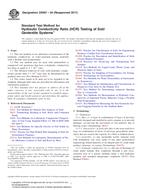
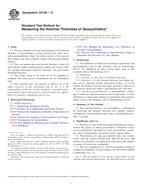 ASTM D5199-12
ASTM D5199-12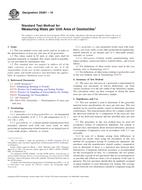 ASTM D5261-10
ASTM D5261-10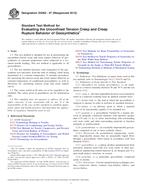 ASTM D5262-07(2012)..
ASTM D5262-07(2012)..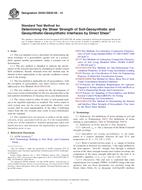 ASTM D5321/D5321M-14..
ASTM D5321/D5321M-14..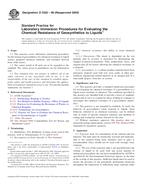 ASTM D5322-98(2009)..
ASTM D5322-98(2009)..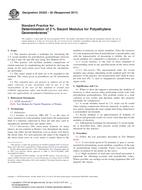 ASTM D5323-92(2011)..
ASTM D5323-92(2011)..
 Cookies
Cookies
